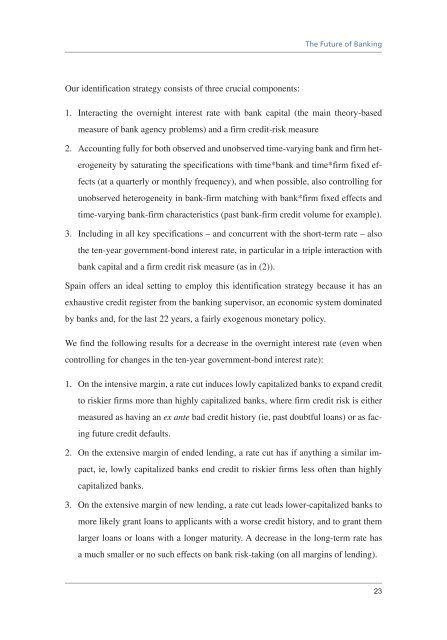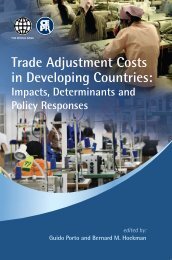You also want an ePaper? Increase the reach of your titles
YUMPU automatically turns print PDFs into web optimized ePapers that Google loves.
Our identification strategy consists of three crucial components:<br />
The Future of Banking<br />
1. Interacting the overnight interest rate with bank capital (the main theory-based<br />
measure of bank agency problems) and a firm credit-risk measure<br />
2. Accounting fully for both observed and unobserved time-varying bank and firm heterogeneity<br />
<strong>by</strong> saturating the specifications with time*bank and time*firm fixed effects<br />
(at a quarterly or monthly frequency), and when possible, also controlling for<br />
unobserved heterogeneity in bank-firm matching with bank*firm fixed effects and<br />
time-varying bank-firm characteristics (past bank-firm credit volume for example).<br />
3. Including in all key specifications – and concurrent with the short-term rate – also<br />
the ten-year government-bond interest rate, in particular in a triple interaction with<br />
bank capital and a firm credit risk measure (as in (2)).<br />
Spain offers an ideal setting to employ this identification strategy because it has an<br />
exhaustive credit register from the banking supervisor, an economic system dominated<br />
<strong>by</strong> banks and, for the last 22 years, a fairly exogenous monetary policy.<br />
We find the following results for a decrease in the overnight interest rate (even when<br />
controlling for changes in the ten-year government-bond interest rate):<br />
1. On the intensive margin, a rate cut induces lowly capitalized banks to expand credit<br />
to riskier firms more than highly capitalized banks, where firm credit risk is either<br />
measured as having an ex ante bad credit history (ie, past doubtful loans) or as facing<br />
future credit defaults.<br />
2. On the extensive margin of ended lending, a rate cut has if anything a similar impact,<br />
ie, lowly capitalized banks end credit to riskier firms less often than highly<br />
capitalized banks.<br />
3. On the extensive margin of new lending, a rate cut leads lower-capitalized banks to<br />
more likely grant loans to applicants with a worse credit history, and to grant them<br />
larger loans or loans with a longer maturity. A decrease in the long-term rate has<br />
a much smaller or no such effects on bank risk-taking (on all margins of lending).<br />
23














